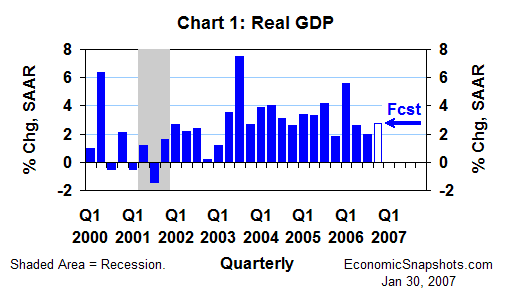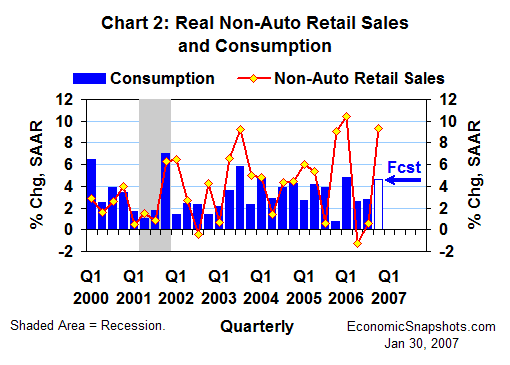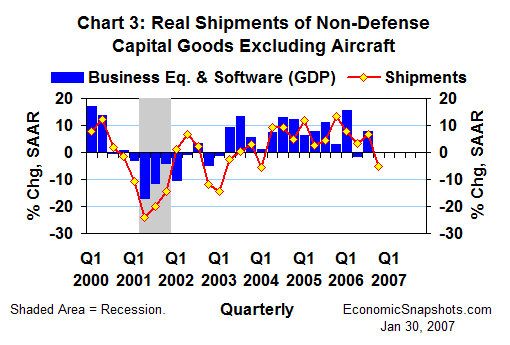
| Back to Index |
January 30, 2007 – U.S. real GDP (coming Wednesday) probably rose at about a 2.8% annual rate in Q4 after a meager 2% Q3 increase (Chart 1).

Stronger real consumption growth and a reduction in the real foreign trade deficit should both contribute to stronger Q4 real GDP growth. These positive effects should be partially offset by weaker real fixed investment and inventory growth.
In the consumption indicators, real non-auto retail sales rose at a whopping 9.4% annual rate in Q4 (+0.6% in Q3, Chart 2), as plummeting energy prices boosted consumers’ purchasing power.

Working to moderate this strength in non-auto consumer good demand, light vehicle sales edged down by 0.3M units to a 16.3M unit annual rate in Q4 (+0.3M units in Q3). And, consumers’ real services purchases were tracking at a staid 2.8% annual rate in the first two months of Q4 (+2.8% for all of Q3).
Even so, real consumption growth might have reached a 4.6% annual rate in Q4 (+2.8% in Q3). That would be the strongest quarterly gain since Q1 last year, when consumption rose by 4.8%.
Beyond consumers, real non-defense capital good shipments excluding aircraft fell at a 5.3% annual rate in Q4 (+6.7% in Q3, Chart 3). This suggests that real business fixed investment in equipment & software probably stopped growing (and may have fallen) in Q4 (+7.7% in Q3).

Based on data through November, real non-residential construction spending probably continued to grow in Q4, but not nearly as fast as Q3’s hefty 15.7% annual rate. At the same time, real residential construction spending seemed to be on track for yet another double digit decline in Q4 (down by 18.7% in Q3).
Putting these pieces together, total real fixed investment (business equipment & software purchases plus residential and non-residential construction spending) may have fallen at roughly a 10% annual rate in Q4 after a 1.2% Q3 decline.
Enhancing this fixed-investment weakness, data through November also suggest that real inventory growth might have slowed by about $15B to about a $40B annual rate in Q4 (measured in chained 2000 dollars). That would reduce Q4 real GDP growth by about a half percentage point. (Inventories added 0.1 percentage point to real GDP growth in Q3.)
However, based on the October-November improvement in the foreign trade balance, real net exports might have risen by about $40B in Q4 to a deficit of roughly $590B. That would add about 1.5 percentage points to Q4 real GDP growth. (Net exports reduced real GDP growth by 0.2 percentage points in Q3.)
Real government spending rose at a 1.7% annual rate in Q3. This forecast assumes similar government spending growth (1.5% to 2%) in Q4.
Suzanne Rizzo